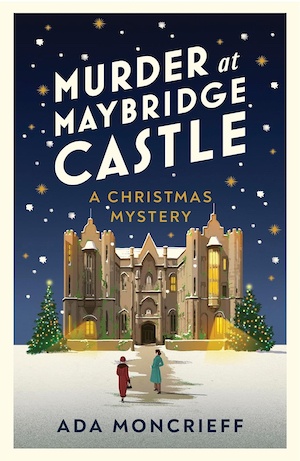
Daphne King, trailblazing crime reporter and fledgling amateur sleuth, returns to tackle more Christmas chaos in Ada Moncrieff’s Murder at Maybridge Castle. It’s December 1936 and Charles Howton, black sheep of playwright Veronica Howton’s family, has invited Daphne and Veronica to spend a pre-Christmas weekend in Cumbria to witness the grand opening of his latest business venture: Maybridge Castle, England’s first haunted hotel.
With Veronica off taking Broadway by storm, Daphne has reluctantly agreed to take a break from chasing criminals across London and enjoy a sojourn in the countryside in support of Charles – phantoms and apparitions permitting, of course. And she’s not the only one Charles has convinced to make the journey north with the promise of seances, tarot readings and mince pies.
Among the motley group of guests that Charles feels sure will garner the hotel maximum publicity are Amelia Thewley, renowned sceptic and debunker (plus feline companion, Duke); newly married John and Eleanor Beaumont, subscribers to Spiritualism Now; Helena Rackham, an academic who studies the history of witchcraft; hotel correspondent Winifred Roberts; and bickering father and son Raymond and Kenneth Hammond.
Initially it seems little unites these folks beyond interest in what a weekend at a haunted hotel will entail, but the drama, insinuations and backbiting that occur over cocktails on their first evening at Maybridge Castle suggest that they all have one thing in common after all: secrets that they’ll do anything to hide.
What’s more, when Charles attempts to lighten the mood by suggesting that they play a game of murder in the dark, he unwittingly sets the scene for an actual slaying. With another ghost seemingly having been added to the castle’s resident spooks and the local constabulary ill-equipped to deal with a murder, Charles turns to Daphne to crack the case and help him avoid yet another failed business venture.
Having made her detective debut in Murder at the Theatre Royal, set in December 1935, Daphne has apparently solved several high-profile cases between then and the events at Maybridge Castle, including the Lord Marcus investigation and shenanigans involving East End gangsters. It’s no surprise then that her confidence and prowess as an investigator have grown considerably, which proves to be particularly unfortunate for the adulterous young man she encounters on the train to Cumbria.
Moreover, this time around she’s ably assisted by septuagenarian sleuth Mrs Thewley, who is a shrewd judge of character and a keen observer of behaviour, in addition to having valuable practical skills in areas such as lockpicking. The pair make a great team, serving as sounding boards for each other’s ideas and adding considerable humour to the story through their dialogue and escapades, particularly when traversing country lanes on a motorbike and sidecar.
They’re not a perfect pair of detectives, however, as they repeatedly put off sharing clues and deductions until late at night or on other occasions, which is not really a sound plan when there is a killer on the loose. In fact, Daphne and Mrs Thewley are oddly reticent about actually solving the crime until circumstances give them a shove. Plus, at one point they both seem to forget a vital piece of information and so temporarily derail their own investigation.
Nevertheless, it’s a lot of fun to follow them on the trail of the killer, especially since Moncrieff does such a good job of allowing events to unfold amid an atmosphere that reflects both the allure of a haunted castle and the forced merriment of Christmas celebrations among strangers. In fact, the partially renovated but still pretty decrepit hotel serves as an evocative backdrop to the unseasonal crime, enhancing the sense of isolation and intrigue that characterises the closed-circle mystery.
Murder at Maybridge Castle is also laced with witticisms worthy of Wodehouse, cleverly plotted twists and plausible red herrings, which ensures that the mystery remains engaging and puzzling until Daphne’s final Poirot-like denouement. Moncrieff’s approach is reminiscent of the greats from the Golden Age of Murder, particularly in terms of the social commentary, eccentricity of motives and integration of diverse human foibles into a singular and convincing murder plot.
Following Murder Most Festive, Murder at the Theatre Royal and now Murder at Maybridge Castle, a murder mystery from Ada Moncrieff is becoming quite the Christmas tradition, and long may it continue!
Also see Hercule Poirot’s Silent Night by Sophie Hannah or A Christmas Murder of Crows by DM Austin.
Harvill Secker
Print/Kindle
£4.50
CFL Rating: 4 Stars


Using our associate/affiliate links helps support the site.








